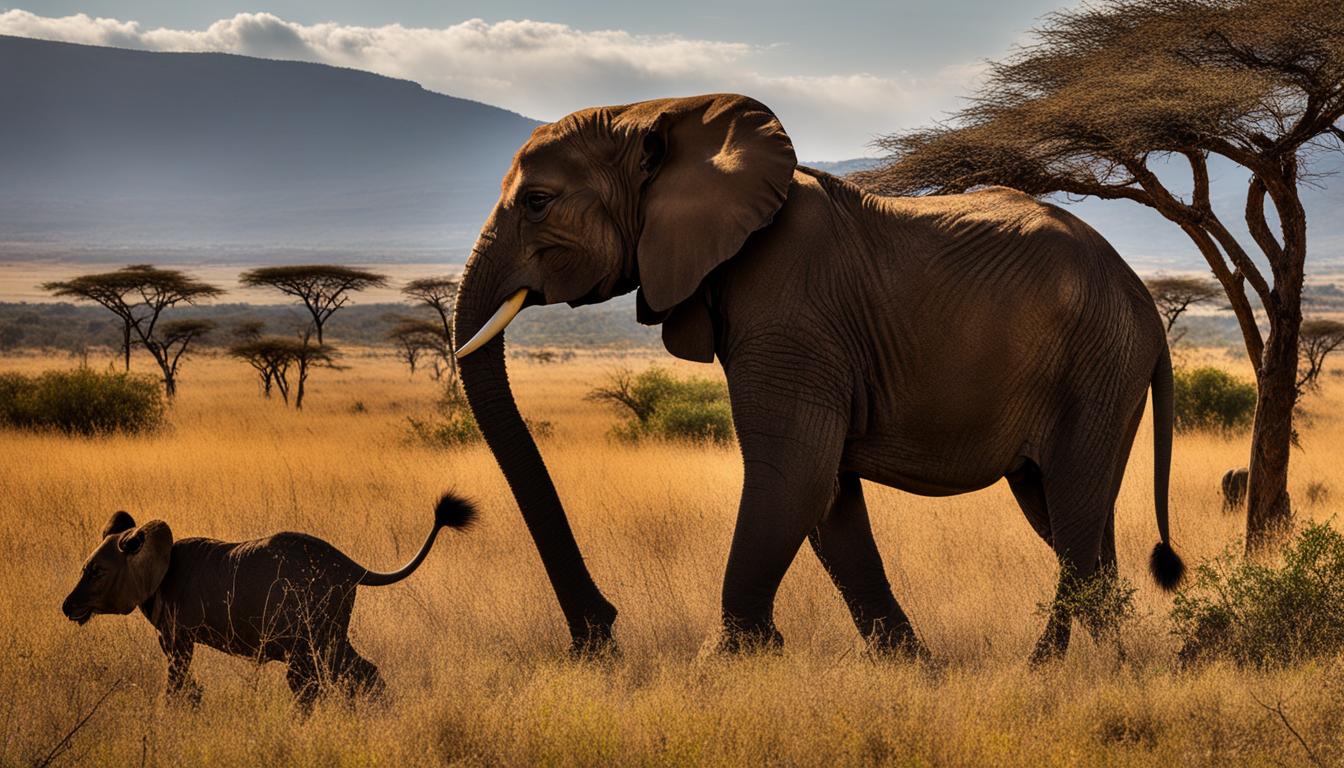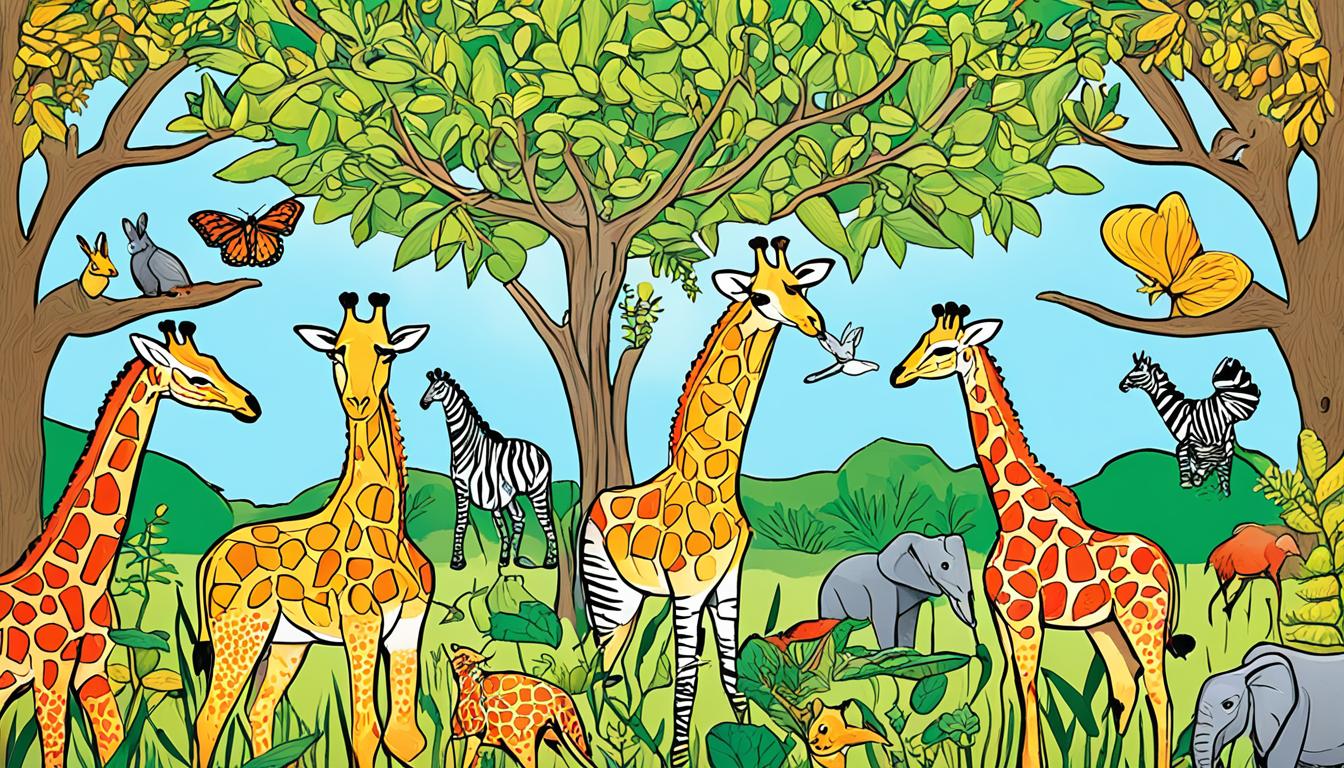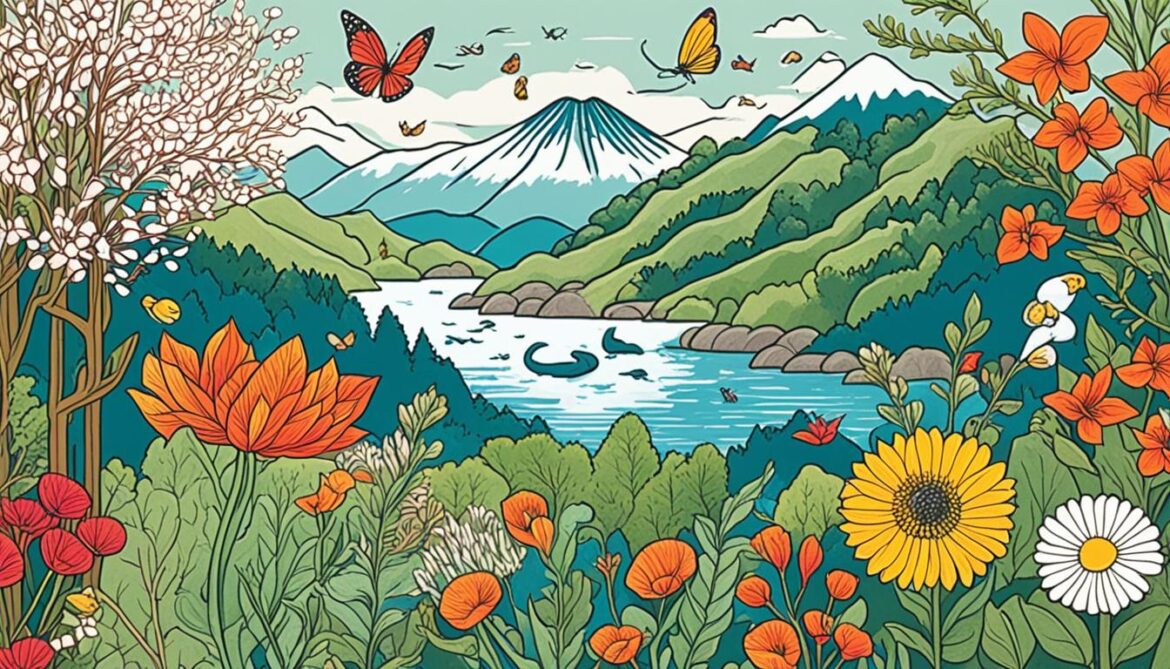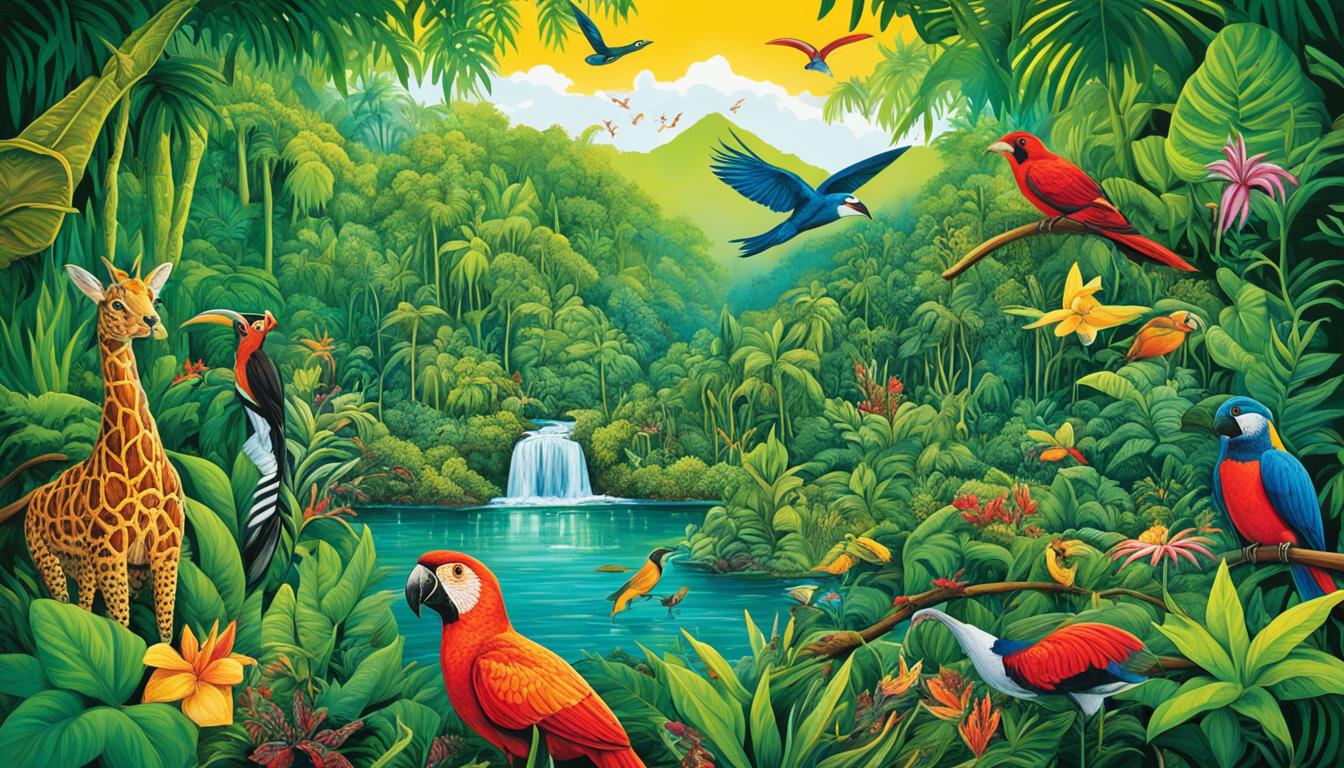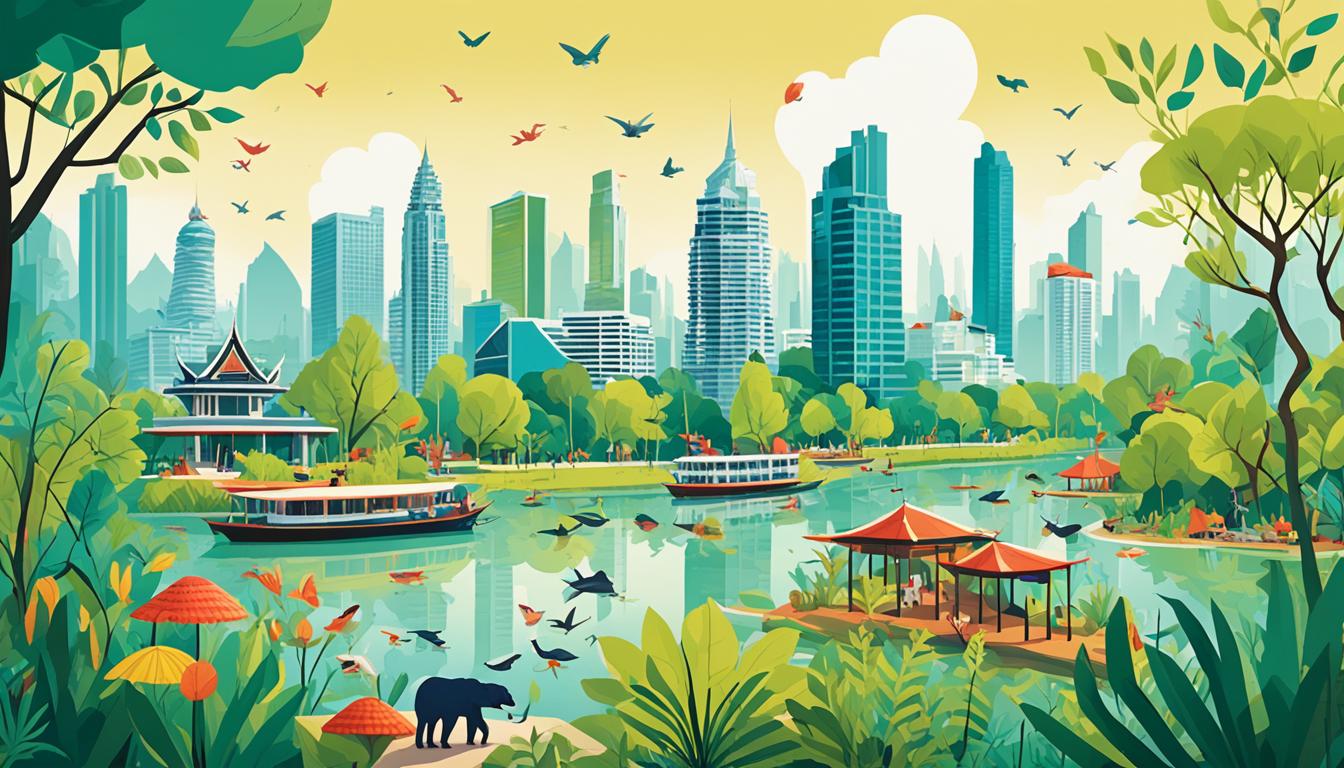South Korea Biodiversity: Animal and Plant Species and What Is Under Threat
In South Korea, biodiversity thrives on a grand scale. With over 100,000 native species and more than 41,000 species found within its borders, the country boasts a diverse array of animal and plant life. Among these species, there are 2,177 endemic species and nearly 38,000 indigenous species, making South Korea a biodiversity hotspot worth exploring and protecting.
From forests to coastal areas, wetlands to tidal flats, South Korea’s varied ecosystems provide habitats for a wide range of wildlife. However, the delicate balance of this ecosystem is now under threat. Habitat loss, climate change, invasive species, and poaching all pose serious challenges to the survival of South Korea’s rich biodiversity.
Key Takeaways:
- South Korea is home to over 100,000 native species and more than 41,000 species overall.
- The country boasts 2,177 endemic species and nearly 38,000 indigenous species.
- Threats to South Korea’s biodiversity include habitat loss, climate change, invasive species, and poaching.
- Efforts are being made to protect endangered species and preserve biodiversity hotspots.
- Expanding protected areas and raising public awareness are key strategies in biodiversity conservation.
The Importance of Wetlands and Tidal Flats for Biodiversity
Wetlands and tidal flats play a crucial role in supporting the unique biodiversity of South Korea. These habitats provide homes for a variety of organisms that have evolved in different environments than their terrestrial and aquatic counterparts.
Wetlands, including marshes, swamps, and bogs, are characterized by water-saturated soil or standing water for a significant part of the year. They serve as breeding grounds, nurseries, and feeding sites for a wide range of wetland species. The wetlands in South Korea are no exception, hosting a diverse array of plant and animal life.
Within these wetlands, species such as otters, spoon-billed sandpipers, and tiny dragonflies thrive. However, the gradual reduction in wetlands poses a threat to the diverse species that rely on them. As wetland areas shrink, these species face a loss of habitat and vital resources, pushing them towards the brink of extinction.
“Wetlands are incredibly valuable ecosystems that provide a wide range of ecological services. They help improve water quality, regulate water flow, and support the health of coastal environments.”
Tidal flats are another important habitat in South Korea’s coastal areas. These areas, consisting of intertidal mudflats and sandflats, experience regular tidal inundation. The expansive tidal flats on the western coast of South Korea are renowned for their rich biodiversity.
Tidal flats support diverse crustacean, fish, and plankton populations, serving as a vital feeding and breeding ground for numerous species. They also play a crucial role in maintaining the ecological balance of coastal ecosystems.
In summary, wetlands and tidal flats are vital habitats for the biodiversity of South Korea. They provide unique environments for a wide range of species, supporting their survival and contributing to the overall coastal biodiversity of the country.
Conservation Efforts for Endangered Species
In South Korea, the conservation of endangered species is a top priority. The country has implemented the Act on Wildlife Protection and Management, which designates 246 endangered species for legal management. These species are divided into two classes, Class I and Class II, based on the severity of their population decline.
The South Korean government is actively involved in restoration programs for endangered species, aiming to protect and conserve regional biodiversity. Currently, around 40 endangered or critical species are under active restoration programs. These programs focus on species such as the Asiatic Black Bear and the Crested Ibis, which play significant roles in the ecosystem.
Furthermore, the government is expanding its efforts in breeding programs to increase the populations of endangered species. These programs aim to reintroduce captive-bred individuals into the wild, strengthening the overall conservation efforts.
Raising public awareness is another crucial aspect of species conservation in South Korea. By educating the public about the importance of preserving endangered species, the government hopes to inspire a sense of responsibility and promote a culture of conservation.
Restoration Programs in Action: The Asiatic Black Bear
One notable example of a restoration program in South Korea is the conservation of the Asiatic Black Bear, also known as the Moon Bear. This species, designated as endangered, has experienced a significant decline in population due to habitat loss and illegal hunting.
To protect and restore the Asiatic Black Bear population, conservation organizations and government agencies have collaborated to establish sanctuaries and protected areas where these bears can thrive. These efforts include habitat restoration, reforestation, and the creation of safe spaces for the bears to live and reproduce.
“The restoration program for the Asiatic Black Bear is a critical step in preserving this iconic species. Through concerted efforts and strong partnerships, we aim to secure a future for these bears in their natural habitat.” – Dr. Park Min-woo, Conservation Biologist
The restoration program for the Asiatic Black Bear not only focuses on protecting the species but also emphasizes the importance of its role in the ecosystem. By conserving the bear’s habitat and ensuring its survival, other flora and fauna that depend on this species will also benefit.
Conserving Cultural Icons: The Crested Ibis
Another species that is undergoing extensive restoration efforts in South Korea is the Crested Ibis. This bird, considered a symbol of good luck and longevity, is critically endangered.
The government and conservation organizations have established breeding centers and research facilities to support the captive breeding and reintroduction of the Crested Ibis into the wild. These efforts have resulted in successful breeding programs and the release of ibises into carefully selected habitats, ensuring their safety and long-term survival.
“The preservation of the Crested Ibis is not just about protecting a species; it’s about preserving our cultural heritage. By safeguarding these beautiful birds, we are also safeguarding a part of our history and identity.” – Dr. Lee Soo-jin, Ornithologist
The conservation of the Crested Ibis is not only vital for its own survival but also carries cultural significance for the people of South Korea. By saving this iconic bird, the country is preserving its cultural heritage and maintaining a deeper connection with its natural environment.
Through restoration programs, breeding initiatives, and public awareness campaigns, South Korea is committed to protecting its endangered species and preserving its rich biodiversity. These efforts ensure that future generations can continue to appreciate and benefit from the unique flora and fauna that call this country home.
Protected Areas and Biodiversity Hotspots
South Korea is committed to preserving its natural heritage through a system of protected areas. These areas encompass a range of designations, including national parks, ecological and scenery conservation areas, wetland protected areas, forest genetic resource protected areas, and national nature reserves. As of the end of 2013, there were 1,402 protected area sites, covering approximately 16.4% of the country’s territory.
While this coverage is a positive step, it still falls below the OECD average. As such, efforts are underway to increase the extent of protected areas in South Korea. In addition to these protected areas, the country boasts five national geoparks and 18 sites listed in the Ramsar List of Wetlands of International Importance.
Furthermore, several notable sites have received recognition as UNESCO Biosphere Reserves. These include Seoraksan, Jejudo, Shinan Dadohae, and Gwangneung Forest. These reserves serve as biodiversity hotspots, safeguarding unique ecosystems and fostering the conservation of South Korea’s rich flora and fauna.
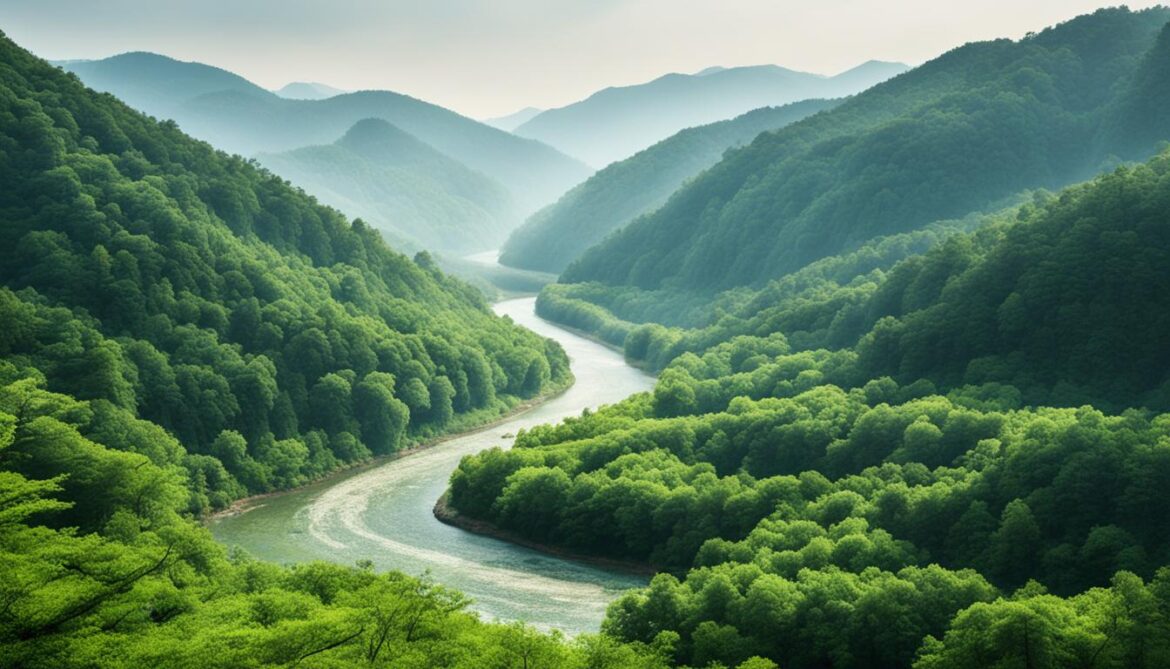
Habitat Loss and Fragmentation from Infrastructure Development
The rapid urbanization and industrialization of South Korea have resulted in significant habitat loss and fragmentation, posing a threat to the country’s biodiversity. Despite efforts in afforestation, the size of wetlands, farmland, and forests has gradually diminished over the past few decades. One of the main contributors to this problem is the development of transportation infrastructure, particularly roads, which has a detrimental impact on biodiversity through disturbance and fragmentation.
The construction of roads not only leads to the destruction of natural habitats but also creates barriers that isolate wildlife populations, preventing them from accessing vital resources and disrupting their natural movement patterns. This fragmentation disrupts ecosystems and can result in a loss of genetic diversity, as well as increased vulnerability to disease and environmental stressors.
One of the most concerning consequences of road development is the high number of wildlife-vehicle collisions. Thousands of animals are killed on roads each year, resulting in the loss of individual species and further contributing to the decline of biodiversity in South Korea.
To address these challenges, it is crucial to prioritize biodiversity conservation alongside infrastructure development. Efforts should be made to implement measures that minimize the negative impacts of transportation infrastructure on wildlife and their habitats.
“The construction of roads not only leads to the destruction of natural habitats but also creates barriers that isolate wildlife populations, preventing them from accessing vital resources and disrupting their natural movement patterns.”
Table: Impact of Infrastructure Development on Biodiversity
| Impact | Description |
|---|---|
| Habitat Loss | Construction activities result in the destruction and conversion of natural habitats. |
| Fragmentation | Roads act as barriers, isolating wildlife populations and disrupting their movement. |
| Wildlife-Vehicle Collisions | High numbers of road kills adversely affect biodiversity, causing the loss of individual species. |
Integrating wildlife crossings, such as overpasses and underpasses, into road design can help mitigate wildlife-vehicle collisions and facilitate the movement of animals across roads. These structures provide safe passage for wildlife, reconnect fragmented habitats, and promote genetic exchange between isolated populations.
Furthermore, pre-construction planning, including ecological surveys and impact assessments, can help identify sensitive areas and design roads that minimize their impact on biodiversity. Implementing post-implementation monitoring programs allows for the evaluation of the effectiveness of mitigation measures and the development of adaptive strategies to address any unforeseen impacts on wildlife.
By prioritizing sustainable infrastructure development and adopting innovative solutions that minimize the negative impacts on biodiversity, South Korea can strike a balance between economic growth and environmental conservation.
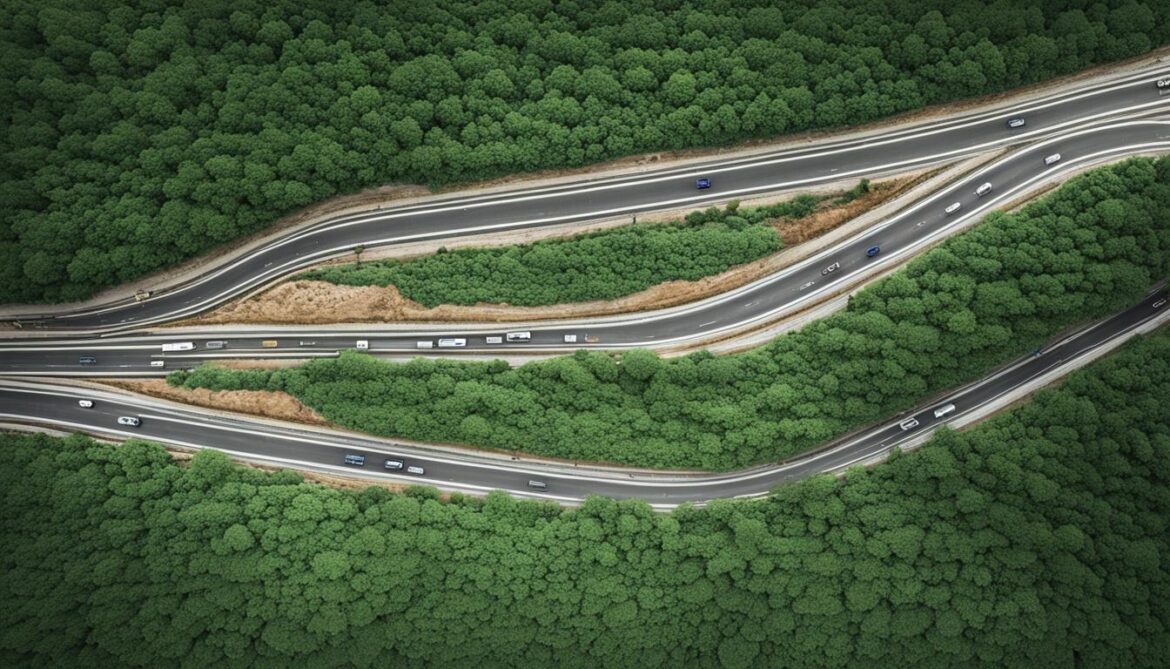
Mitigation Measures for Biodiversity Conservation
South Korea is taking significant steps to mitigate the impacts of infrastructure development on biodiversity. By implementing various measures, the government aims to safeguard the country’s natural treasures and promote sustainable growth.
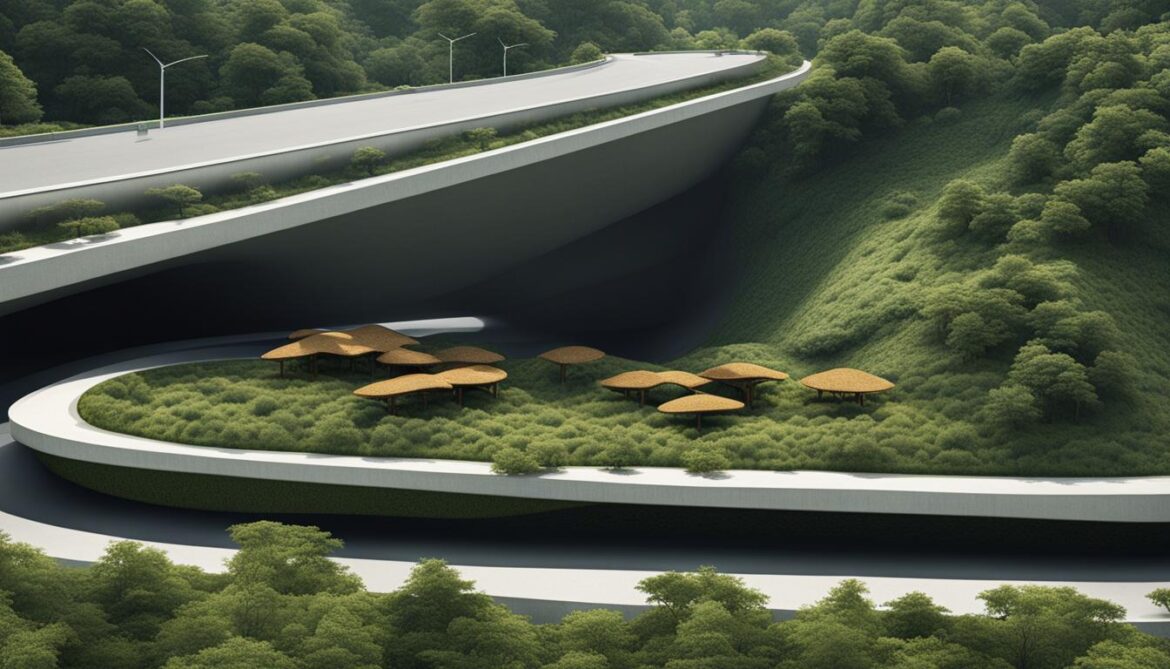
Reducing Wildlife-Vehicle Collisions
One effective strategy employed by South Korea is the construction of wildlife crossing structures, such as overpasses and underpasses. These structures provide safe pathways for animals to cross roads, reducing the risk of wildlife-vehicle collisions that often result in fatalities.
“Wildlife crossing structures serve as lifelines for animals, allowing them to navigate their habitats safely while minimizing conflicts with human infrastructure.”
Pre-construction planning and post-implementation monitoring are essential for ensuring the effectiveness of wildlife crossing structures. By carefully considering the ecological needs of local wildlife during the planning stage and monitoring their usage, South Korea maximizes the success of these mitigation measures.
Expanding Protected Areas
To mitigate biodiversity loss, South Korea is actively expanding its network of protected areas. By designating crucial habitats as protected areas, the government aims to safeguard ecosystems and safeguard endangered species.
Protected areas provide essential refuge for vulnerable flora and fauna, allowing them to thrive in relatively undisturbed environments. These areas contribute to the overall conservation efforts in South Korea, ensuring the long-term survival of biodiversity.
Conserving Genetic Diversity
Recognizing the importance of genetic diversity for species’ resilience and adaptability, South Korea has prioritized the conservation of genetic resources. By preserving a wide range of genetic variations within species, the country safeguards their ability to adapt to changing environmental conditions.
Conservation efforts include seed banks, genetic repositories, and breeding programs that prioritize maintaining diverse gene pools. By conserving genetic diversity, South Korea enhances the resilience of its ecosystems and strengthens biodiversity conservation measures.
Climate Change Countermeasures
South Korea acknowledges the significant impact of climate change on biodiversity and has taken proactive steps to address this issue. Through the implementation of climate change countermeasures, the country aims to mitigate the adverse effects and safeguard its unique ecosystems.
These countermeasures include habitat restoration, reforestation projects, and the promotion of sustainable practices to reduce greenhouse gas emissions. By adapting to climate change and reducing its ecological footprint, South Korea supports the long-term stability of its biodiversity.
Enhancing Education and Public Awareness
South Korea recognizes the importance of fostering a culture of environmental stewardship and raising public awareness about biodiversity conservation. By educating the public about the value of biodiversity and the role individuals can play in protecting it, the government aims to instill a sense of responsibility towards nature.
Education initiatives, public outreach programs, and the integration of biodiversity topics into school curricula are key components of South Korea’s efforts to promote environmental consciousness among its citizens.
By implementing these mitigation measures and striking a balance between economic development and environmental protection, South Korea is actively promoting the conservation and sustainable management of its biodiversity.
South Korea’s National Biodiversity Strategies
South Korea has been taking significant steps to enhance biodiversity conservation through the implementation of National Biodiversity Strategies and Action Plans (NBSAPs). The latest NBSAP, covering the period of 2014-2018, focuses on key objectives such as the equitable sharing of benefits from biodiversity, the sustainable use of genetic resources, and strengthening action plans for ecosystem threats.
The government of South Korea has been working diligently to expand biodiversity conservation infrastructure and promote the sustainable use of ecosystems. International cooperation is also a priority, as the country recognizes the global importance of preserving biodiversity.
Despite progress in various areas, there is still a need for improvement in expanding protected areas and addressing the impacts of climate change on biodiversity. South Korea remains committed to advancing its strategic plan for biodiversity and ensuring the long-term sustainability of its ecosystems.

“Biodiversity is our most valuable asset, and conservation is essential for the well-being of present and future generations.” – South Korean Ministry of Environment
The Expansion of Biodiversity Conservation Infrastructure
South Korea has been actively working towards expanding its biodiversity conservation infrastructure. By establishing and enhancing protected areas, the country aims to create safe havens for endangered species and ecosystems. The table below highlights the protected areas established in South Korea:
| Type of Protected Area | Number of Sites |
|---|---|
| National Parks | 20 |
| Ecological and Scenery Conservation Areas | 236 |
| Wetland Protected Areas | 47 |
| Forest Genetic Resource Protected Areas | 14 |
| National Nature Reserves | 1,085 |
Furthermore, South Korea has designated five national geoparks and 18 areas listed in the Ramsar List of Wetlands of International Importance. These protected areas contribute significantly to the conservation of biodiversity.
The immense efforts to expand protected areas have resulted in 16.4% of the country’s territory being designated as protected areas. While this falls below the OECD average, South Korea remains committed to increasing protected area coverage in the future.
South Korea’s National Biodiversity Strategies and Action Plans (NBSAPs) have been instrumental in promoting biodiversity conservation. By focusing on the equitable sharing of benefits from biodiversity, the sustainable use of genetic resources, and strengthening action plans for ecosystem threats, South Korea aims to enhance biodiversity conservation and ensure the long-term sustainability of its ecosystems.
The expansion of biodiversity conservation infrastructure, such as establishing and enhancing protected areas, is a key aspect of South Korea’s NBSAPs. The country has a well-developed system of protected areas, including national parks, ecological and scenery conservation areas, wetland protected areas, forest genetic resource protected areas, and national nature reserves. These protected areas cover 16.4% of the country’s territory, providing safe havens for endangered species and ecosystems.
Furthermore, South Korea is actively involved in international cooperation for biodiversity conservation. The country recognizes the importance of global collaboration in preserving biodiversity and has been working towards enhancing international partnerships.
“Biodiversity is the foundation of life on Earth, and its conservation is a shared responsibility. By actively implementing strategic plans for biodiversity, South Korea aims to contribute to the global efforts in biodiversity conservation.” – South Korean Ministry of Environment
South Korea’s Efforts towards the Aichi Biodiversity Targets
South Korea is dedicated to the achievement of the Aichi Biodiversity Targets and has implemented various initiatives and partnerships to support biodiversity conservation. As an important step towards this goal, the country hosted the Conference of the Parties (COP-12) in Pyeongchang in 2014, where it proposed the Pyeongchang Roadmap 2020. This roadmap aims to strengthen the implementation of the Strategic Plan for Biodiversity 2011-2020 through targeted actions and initiatives.
To ensure effective collaboration and involvement, the Ministry of Environment has established partnerships with the business sector. Representatives from the business sector actively participate in the National Biodiversity Committee, contributing their expertise and resources to biodiversity programs and conservation efforts. This partnership approach promotes a comprehensive and sustainable approach to biodiversity management.
In South Korea, we believe that successful biodiversity conservation requires the participation of all stakeholders. By partnering with the business sector, we can leverage their resources and expertise to support concrete initiatives and enhance biodiversity conservation in the country.
Biodiversity Initiatives in South Korea
South Korea has implemented a range of initiatives to promote biodiversity conservation. These initiatives include:
- Establishing protected areas and expanding their coverage to safeguard critical habitats and ecosystems;
- Implementing restoration programs for endangered species, focusing on habitat restoration and population recovery;
- Integrating biodiversity considerations into land-use planning and development processes;
- Investing in research and monitoring to improve understanding of South Korea’s unique flora and fauna;
- Enacting legislation and regulations to enforce wildlife protection and combat illegal activities;
- Enhancing public awareness and education programs to promote a culture of biodiversity conservation.
By implementing these initiatives and collaborating with various stakeholders, South Korea is actively working towards the achievement of the Aichi Biodiversity Targets. Through these collective efforts, the country aims to protect and preserve its valuable biodiversity for present and future generations.
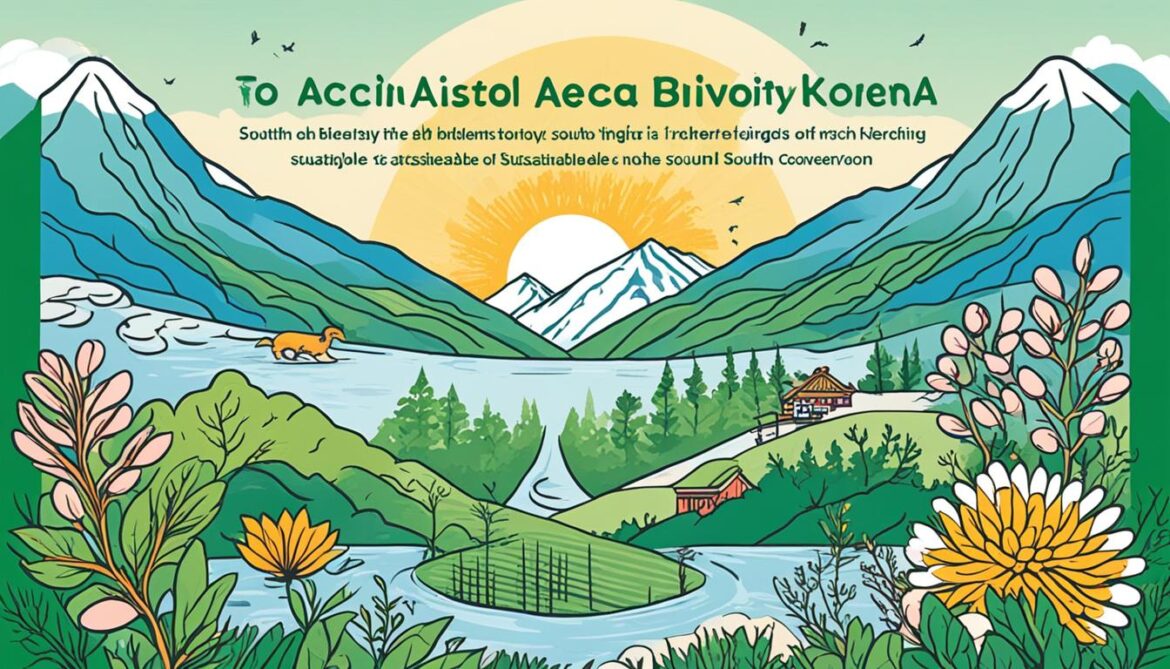
| Initiatives | Description |
|---|---|
| Protected Areas | Establishing and expanding protected areas to safeguard critical habitats and ecosystems. |
| Restoration Programs | Implementing programs to restore habitats and recover populations of endangered species. |
| Land-use Planning | Integrating biodiversity considerations into land-use planning and development processes. |
| Research and Monitoring | Investing in research and monitoring to improve understanding of South Korea’s unique flora and fauna. |
| Legislation and Regulations | Enacting laws and regulations to enforce wildlife protection and combat illegal activities. |
| Public Awareness | Enhancing public awareness and education programs to promote biodiversity conservation. |
The Distribution and Conservation of Endangered Plant Species
South Korea is home to a wide range of endangered plant species. The IUCN Red List of Threatened Species has designated several plants as endangered, including the Korean Lady’s Slipper, Pincushion Plant, Mankyua, Yellow-Flowered Rosebay, Danyang Aster, and Northern Water Hemlock.

The country has implemented measures to protect and manage these plant species, and efforts are being made to conserve and restore their populations. Climate change poses a threat to the distribution range of these plant species, particularly for northern plant species, which are experiencing a decline in population.
Endangered Plant Species in South Korea:
| Plant Species | Conservation Status |
|---|---|
| Korean Lady’s Slipper | Endangered |
| Pincushion Plant | Endangered |
| Mankyua | Endangered |
| Yellow-Flowered Rosebay | Endangered |
| Danyang Aster | Endangered |
| Northern Water Hemlock | Endangered |
“Conservation is vital to protect the endangered plant species in South Korea and ensure their survival for future generations.” – South Korean Ministry of Environment
Efforts to conserve these plant species involve habitat restoration, controlled cultivation, and the implementation of legal measures to prevent their exploitation. Conservation organizations work closely with local communities and researchers to raise awareness about the importance of preserving these unique plant species and their ecosystems.
- Implementing habitat restoration projects.
- Establishing protected areas to safeguard critical plant habitats.
- Conducting research to understand the ecology and behavior of endangered plant species.
- Promoting public education and awareness campaigns to highlight the value of plant conservation in South Korea.
By taking these proactive conservation measures, South Korea aims to protect its endangered plant species and ensure the long-term sustainability of its rich botanical heritage.
South Korea’s Unique Flora and Fauna
South Korea boasts a remarkable array of flora and fauna, thanks to its distinctive climate and geography. The country provides a habitat for a diverse range of species, both native and endemic, making it a biodiversity hotspot.
Coexistence of Southern and Northern Plant Species
South Korea’s unique climatic conditions allow for the coexistence of both southern and northern plant species. The country’s location on the Korean Peninsula, which experiences both warm and cold climates, creates a perfect environment for a wide variety of plants to thrive. This coexistence adds to the ecological diversity of South Korea’s ecosystems, contributing to its rich biodiversity.
Endemic Species and Conservation Efforts
South Korea is home to 436 endemic species, which are found nowhere else in the world. These unique species face the risk of endangerment, with 15 of them currently designated as endangered. Efforts are underway to conserve and protect these endemic species, preserving their habitats and promoting sustainable practices.
“The conservation of South Korea’s endemic species is vital to maintaining the country’s ecological balance and biodiversity. It is our responsibility to safeguard these unique plants and animals for future generations.”
Endangered Mammals, Birds, Amphibians, and Reptiles
The Korean Peninsula provides a habitat to a variety of endangered mammals, birds, amphibians, and reptiles. These species play a crucial role in maintaining the delicate balance of South Korea’s ecosystems. Conservation efforts are focused on protecting these vulnerable species and their habitats through habitat restoration, wildlife management programs, and public education initiatives.
Challenges and Future of Biodiversity Conservation in South Korea
While South Korea has made progress in biodiversity conservation, there are still challenges that need to be addressed. Habitat loss, climate change, invasive species, and illegal activities remain significant threats to biodiversity. It is essential to strike a balance between economic development and environmental protection to ensure the long-term survival and health of South Korea’s diverse ecosystems.
The future of biodiversity in South Korea depends on effective conservation strategies and proactive measures. One of the key strategies is the expansion of protected areas, which provide vital habitats for numerous plant and animal species. By designating and increasing the size of protected areas, South Korea can safeguard crucial ecosystems and create safe havens for endangered species.
Another important aspect of biodiversity conservation is the implementation of sustainable practices. South Korea needs to promote sustainable agricultural and forestry practices that reduce habitat destruction and minimize negative impacts on biodiversity. By embracing sustainable resource management and promoting sustainable livelihoods, the country can mitigate the adverse effects of human activities on its ecosystems.
Raising public awareness about the importance of biodiversity is also crucial for its conservation. Education and outreach programs can inform the public about the ecological value of South Korea’s flora and fauna and the need to protect them. By fostering a sense of environmental stewardship among the population, South Korea can garner greater support for conservation efforts and inspire individuals to contribute to biodiversity conservation.
Collaboration between government agencies, businesses, and civil society is essential for effective biodiversity conservation. By working together, stakeholders can share resources, knowledge, and expertise to develop and implement comprehensive conservation strategies. These partnerships can lead to innovative approaches and collective action that are vital for protecting South Korea’s unique biodiversity.
As South Korea seeks to address the challenges posed by habitat loss, climate change, invasive species, and illegal activities, it has the opportunity to shape the future of biodiversity conservation in the country. By adopting sustainable practices, expanding protected areas, raising public awareness, and fostering collaboration, South Korea can create a more sustainable and biodiverse future for its ecosystems and the species that call them home.
Conclusion
South Korea’s biodiversity is a valuable and fragile asset that is currently facing numerous threats. The country’s unique climate and geography provide a diverse range of habitats that support a rich tapestry of flora and fauna. However, habitat loss, climate change, and human activities pose significant challenges to biodiversity conservation in South Korea.
Efforts are being made to protect endangered species, expand protected areas, and raise public awareness about the importance of biodiversity. By implementing these measures, South Korea aims to ensure the long-term sustainability of its ecosystems and preserve its precious biodiversity for future generations.
It is crucial that South Korea continues its commitment to biodiversity conservation and takes proactive steps to address the challenges it faces. Collaboration among government agencies, businesses, and civil society will be key in achieving these goals. Together, we can protect and preserve the unique and diverse ecosystems of South Korea, safeguarding its invaluable natural heritage.




